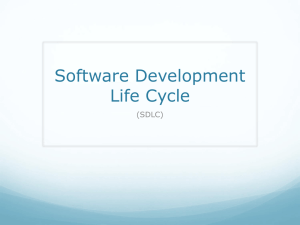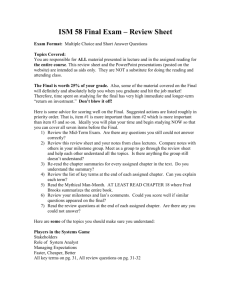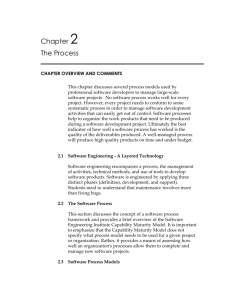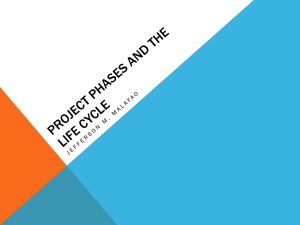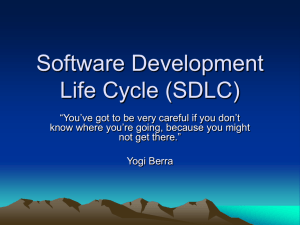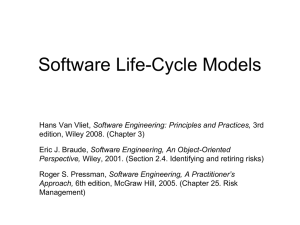3. Introduction to Project Life Cycle
advertisement
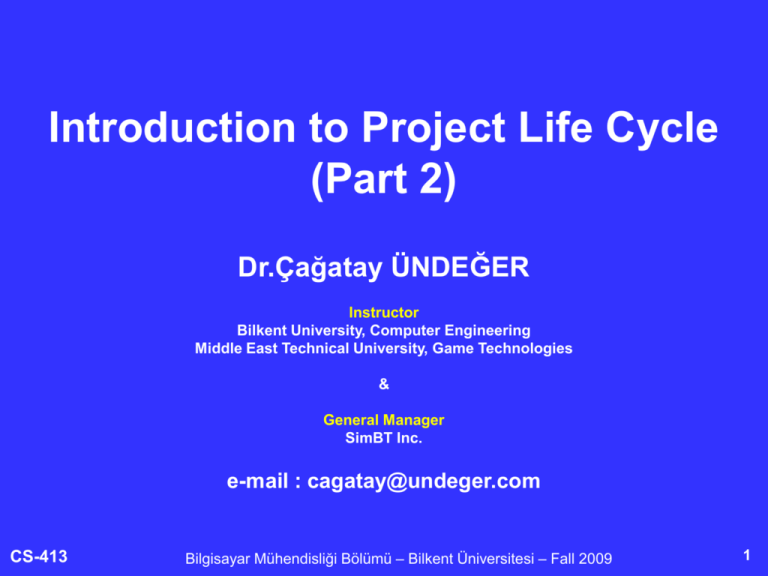
Introduction to Project Life Cycle (Part 2) Dr.Çağatay ÜNDEĞER Instructor Bilkent University, Computer Engineering Middle East Technical University, Game Technologies & General Manager SimBT Inc. e-mail : cagatay@undeger.com CS-413 Bilgisayar Mühendisliği Bölümü – Bilkent Üniversitesi – Fall 2009 1 Introduction To Project Life Cycle • • • CS-413 What is a Project Life Cycle? – Project management life cycle – System development life cycle (process model) Usual Phases of Process Models – Planning – Analysis – Design – Implementation – Deployment – Maintenance Prescriptive Process Models – Waterfall Model – Incremental Process Models – Evolutionary Process Models 2 Introduction (Project Management Life Cycle) • Contains the management phases (project management process groups) a project goes through from concept to completion. • The project management process groups: – Initiating, planning – Planning, – Executing, initiating closing – Controlling, – Closing. executing CS-413 3 Introduction (Process Group Overlap) CS-413 4 Introduction (System Development Life Cycle) • System development life cycle (process model); – Contains the development phases a project goes through from planning to maintenance. planning CS-413 maintenance 5 Introduction (Process Model) • Defines a distinct set of; – Activities, – Actions, – Tasks, – Milestones, and – Work products that are required to engineer high quality software. • Not perfect, but provide a useful road map. CS-413 6 Usual Phases of Process Models planning maintenance CS-413 analysis implementation Planning Analysis Design Implementation Deployment Maintenance design • • • • • • deployment 7 Phases of Process Models • Generally, the deliverables (documents, programs, hardware and data) from one phase are approved before the next phase starts. • Every process model must be adapted so that it is used effectively for a specific software project. CS-413 8 Project Management Life Cycle vs. Process Models • Project management life cycle contains umbrella activities that cover process models looking from a higher perspective. planning analysis design planning closing Process model executing maintenance CS-413 implementation initiating deployment 9 Introduction To Project Life Cycle • • • CS-413 What is a Project Life Cycle? – Project management life cycle – System development life cycle (process model) Usual Phases of Process Models – Planning – Analysis – Design – Implementation – Deployment – Maintenance Prescriptive Process Models – Waterfall Model – Incremental Process Models – Evolutionary Process Models 10 Phases of Process Models (Planning) • • • • • • CS-413 Planning Analysis Design Implementation Deployment Maintenance 11 Phases of Process Models (Planning) • The phase where; – Need for a new or enhanced system is identified, and – Proposed system’s scope is determined. CS-413 12 Planning Activities • Identification of needs • Determination of scope • Preparation of baseline project plan scope quality cost CS-413 time 13 Identification of Needs • The organization’s information needs are examined, • The project’s coarse requirements are identified. • The system analysts prioritize and translate the coarse requirements into a written document including; – a course description of the user needs, – feasibility statement and – a coarse schedule. CS-413 14 Determination of Scope • The requested system is further investigated by the system analysts, and • The scope of the system is determined. CS-413 15 Preparation of Baseline Project Plan • The system analysts produce a specific plan for the development, which is called the baseline project plan. • This project plan; – Customizes a process model and specifies the time and resources required for its execution. CS-413 16 Baseline Project Plan • The baseline project plan contains: – A Software Project Management Plan (SPMP) is written to guide the management procedures. – A Software Configuration Management Plan (SCMP) may be written in order to assure that the change management is performed in a control way. – A Software Quality Assurance Plan (SQAP) may be written to guide the quality assurance procedures. – A Software Validation & Verification (V&V) Plan (SVVP) may be written to guide the validation and verification procedures. CS-413 17 Who plans, and How? • Usually performed by the users and the development team together, • The first draft of plan is usually prepared before the project formally starts. • The plan may sometimes split into two primary documents: – Project Description Document (customer) – Tender (developer) CS-413 18 Primary Documents • Project Description Document: – Definition of the requirements – Includes needs, and scope – Usually a less technical document • Tender: – A proposal to meet the requirements – Includes needs, scope, and the baseline project plan – Usually a more technical document • There are many ways these documents are prepared. CS-413 19 Sample Case 1 • Project description document is written (customer). • Requested system is put out to tender (awarding). • Each interested IT company submits the customer what they propose to do with a formal written document, Tender. • Tender includes: – Objective of the system, – Scope of the system, – How they develop the system, – Proposed deliverables of the system, – Cost and time required for the development, – Baseline project plan. • Customer selects one of the tenders/company, and the project is started. CS-413 20 Sample Case 2 • Project description document is written (IT company) • The company estimates the requirements of a specific customer. • Project description document is transformed into a tender, and presented to the customer. • If customer finds the tender acceptable, – Project is started with the company that proposes the system. CS-413 21 Sample Case 3 • Project description document is written (IT company) – In order to solve the requirements of a specific market. • Project is started internally within the organization, • A commercial of the shelf (COTS) product is constructed to be sold in the market. CS-413 22 Sample Case 4 • Project may be evaluated and started within the organization for internal use. CS-413 23 Project Definition Document • A document that; – Defines the requirements of the user • Including the needs and the scope. • The first part of your term project will be; – A Project Definition Document (5%) • A translated (English) template for project definition document of Secretariat of Defense Industry (Savunma Sanayii Müsteşarlığı SSM) will be provided. CS-413 24 Software Project Management Plan (SPMP) • Institute of Electrical and Electronics Engineers (IEEE) 1058 standard that; – Defines the approach to be used by the project team • To deliver the intended project management scope of the project [Wikipedia]. • The second part of your term project will be; – A Software Project Management Plan (10%) CS-413 25 Software Configuration Management Plan (SCMP) • CS-413 IEEE 828 standard that; – Speficies the form of the document used; – To control and monitor the change in evolution of a software system [Walla Wall College] . 26 Software Quality Assurance Plan (SQAP) • CS-413 IEEE 730 standard that; – Defines the techniques, procedures, and methodologies that will be used; • To assure timely delivery of the software that meets specified requirements within the project resources [Center for Space Research]. 27 Software Validation & Verification Plan (SVVP) • IEEE 1012 standard that; – Specifies the form of the document used • To check that a software product meets specifications and that it fulfills its intended purpose [Wikipedia]. • Software Validation is the process of; – Assuring that expected requirements defined fully satisfies real requirements. • Software Verification is the process of; – Assuring that software fully satisfies all the expected requirements defined. CS-413 28 Phases of Process Models (Analysis) • • • • • • CS-413 Planning Analysis Design Implementation Deployment Maintenance 29 Phases of Process Models (Analysis) • The phase where; – The system requirements are determined, – Alternative solutions are developed, and – One is chosen that best meets those requirements given; • Cost, • Labor, and • Technical resources the organization is willing to commit. CS-413 30 Analysis Activities • Requirements of the system are determined. • Requirements of the system are structured. • Alternative designs are generated. CS-413 31 Determining Requirements • Analysts work with users to determine exactly what the users will want from the proposed system. • This sub-phase requires a careful study of the any current systems linked to the proposed system. CS-413 32 Structuring Requirements • The analysts study the requirements, and • Structure them according to their relationships, eliminating any redundancies. CS-413 33 Generating Alternative Designs • The analysts generate alternative designs to meet the user requirements. • They compare the designs in order to determine; – Which one best meets the requirements given; • Cost, • Labor, and • Technical resources the organization is willing to commit to the project development. CS-413 34 Output of Analysis • The output of the analysis phase will be a description of the solution, – Software Requirements Specification (SRS) document, finally recommended by the analysis team. CS-413 35 Software Requirements Specification (SRS) • IEEE 830 standard that; – Specifies the form of the document used; • To complete description of the behavior of the system to be developed [Wikipedia]. • The third part of your term project will be; – A Software Requirements Specification (15%) CS-413 36 Phases of Process Models (Design) • • • • • • CS-413 Planning Analysis Design Implementation Deployment Maintenance 37 Phases of Process Models (Design) • The phase where; – Description of the recommended alternative are converted into; • A logical description and then into a physical system specification. • Design all the aspects of the system; – From input and output screens – To reports, databases, algorithms, and computer processes. CS-413 38 Design Activities • Developing logical system design • Generating physical system specifications CS-413 39 Developing Logical System Design • Focuses on; – The business aspects of the system. • Design is not tied to; – Any specific hardware or system software platform. • Theoretically, designed system could be implemented using; – Any hardware and system software platform. CS-413 40 Generating Physical System Specifications • Converts logical design into technical specifications. • The logical design is broken down into; – Smaller and smaller system units; • That can be converted to computer instructions in a programming language. • Details of the implementation environment are specified. CS-413 41 Details of Implementation Environment • • • • CS-413 Hardware platforms and operating systems, Programming languages, Database systems and file structures, Network environment. 42 Output of Design • The output of the design phase will be a description of the solution, – Software Design Description (SDD) document, ready to be delivered to the programmers and other system builders for implementation. CS-413 43 Software Design Description (SDD) • IEEE 1016 standard that; – Specifies the form of the document used; • To specify; –System architecture and –Application design in a software related project [Wikipedia]. • The fourth part of your term project will be; – A Software Design Description (15%) CS-413 44 Phases of Process Models (Implementation) • • • • • • CS-413 Planning Analysis Design Implementation Deployment Maintenance 45 Phases of Process Models (Implementation) • The phase where; – The system specifications are turned into a working system that is; • Tested and • Ready to use. CS-413 46 Implementation Activities • Coding • Testing • Writing user manuals CS-413 47 Coding • Programmers write the programs that make up the system: – Developing system units – Integrating system units – Correcting bugs CS-413 48 Testing • A Software Test Documentation (STD) is written to guide the testing, and the reporting of the test results. • Programmers and analysts test; – Individiual programs (unit tests), and – Entire system (integration tests) • Guided by the software test plan in order to find and correct errors. • During testing, sample data entry and data production might be required. CS-413 49 Software Test Documentation (SDD) • IEEE 829 standard that; – Specifies the form of the document used; • To defined stages of software testing, each stage potentially producing its own separate type of document [Wikipedia]. CS-413 50 Writing User Manuals • The user manuals are written as; – A hard copy documentation, – A soft copy documentation, and – An interactive help. CS-413 51 Phases of Process Models (Deployment) • • • • • • CS-413 Planning Analysis Design Implementation Deployment Maintenance 52 Phases of Process Models (Deployment) • The phase where; – The implemented system is installed to the organization for actual use. CS-413 53 Deployment Activities • Application software is installed to the organization. • Baseline data is entered to the system. • Users are introduced to the new system and trained. • The new system becomes a part of the daily activities of the organization. CS-413 54 Phases of Process Models (Maintenance) • • • • • • CS-413 Planning Analysis Design Implementation Deployment Maintenance 55 Phases of Process Models (Maintenance) • The phase where; – Programmers make; • Changes that users ask for, and • Modify the system to reflect changing business conditions. CS-413 56 Time & Effort of Maintenance • The amount of time and effort devoted to; – System enhancement during the maintenance phase depends on; • How well the previous life cycle phases were completed. CS-413 57 Maintenance vs. Replacement • There inevitably comes a time when an information system no longer performs as desired, – When the costs of keeping it running becomes prohibitive, or – When the organization’s needs have changed substantially. • Such problems indicate that it is time to begin the design of the system’s replacement. CS-413 58 Introduction To Project Life Cycle • • • CS-413 What is a Project Life Cycle? – Project management life cycle – System development life cycle (process model) Usual Phases of Process Models – Planning – Analysis – Design – Implementation – Deployment – Maintenance Prescriptive Process Models – Waterfall Model – Incremental Process Models – Evolutionary Process Models 59 Prescriptive Process Models • Water Fall Model • Incremental Process Models – The Incremental Model – The RAD Model • Evolutionary Process Models – Prototyping Model – The Spiral Model – Concurrent Development Model CS-413 60 Water Fall Model • The requirements of the problem can be wellunderstood. • The work flow from planning to maintenance could be easily seen. • In that case; – Development process should not need to be so complicated, and – Could be provided by the simplest model called waterfall. CS-413 61 Water Fall Model (Classical Life Cycle) • Suggests a; – Systematic, – Sequential, – Linear approach to software development that; • Progresses through planning to maintenance phases in one iteration. • Oldest process model, • But very efficient for simple projects. Water fall model Planning CS-413 Analysis Design Implementation Deployment Maintenance 62 Where to use? Advantages? Drawbacks? CS-413 63 Water Fall Model (Drawbacks) • Drawbacks: – Real projects are not usually simple, and • Rarely follow the sequential model. – Often very difficult for customer to define all the requirements from the beginning. – Customer must have patience, • Since working version of a product could not be delivered –Until late in the project time-line. • Rarely preferred in project development. CS-413 64 Incremental Process Models • The initial software requirements of the problem can be well-understood; – But overall scope of the development effort does not follow a purely linear process. • There can be necessary need; – To provide a rapid, limited version of the system to the users. • System could be refined and expanded in later versions. CS-413 65 Incremental Process Models (The Incremental Model) • Combines elements of waterfall model applied in an iterative staggered fashion. • Each of iterations; – Is a linear sequence like waterfall model, – Provides a limited version of the system. The incremental model Planning Analysis Design Version 2.0 Implementation Planning Deployment Analysis Version 3.0 CS-413 Planning Maintenance Design Version 1.0 Implementation Analysis Design Deployment Implementation Maintenance Deployment Maintenance 66 Incremental Process Models (The Incremental Model) • First iteration builds the core product with basic functionality, – But many supplementary features remain undelivered. • Following iterations build new versions that – Increase the functionality of the system. • After the end of an-iteration or late in the time-line of an-iteration; – Next iteration is planned, and – Started. CS-413 67 Where to use? Advantages? Drawbacks? CS-413 68 The Incremental Model (Drawback) • If requirements of system for iterations, especially for first one, are not wellunderstood, – Hard to apply this process model, • Since iterations follow classic waterfall model. CS-413 69 Incremental Process Models (The RAD Model) • Rapid Application Development (RAD) model; – An incremental software process model – Emphasizes a short development cycle • by splitting system into modules that are developed in parallel. The RAD model Design Implementation RAD team 1 (module 1) Analysis Design Implementation RAD team 2 (module 2) Planning Analysis Design integration splitting Analysis Deployment Maintenance Implementation RAD team 3 (module 3) Analysis CS-413 Design Implementation RAD team 4 (module 4) 70 Advantages? Drawbacks? CS-413 71 Incremental Process Models (The RAD Model) • If requirements are well-understood and project scope is not very large; – RAD process model enables a development team to create a full functional system in a very short period of time. CS-413 72 Incremental Process Models (The RAD Model) • A good planning is essential, – Since system should be split into well defined modules that; • Enable multiple teams work in parallel with weak interactions. CS-413 73 Incremental Process Models (The RAD Model) • Implementation usually focuses on; – Using pre-existing software components – And application of automatic code generation. • At the end of implementation, – Seperate modules are integrated to form the whole system. CS-413 74 The RAD Model (Drawbacks) • For large scalable projects, – RAD requires sufficient human resource to create the right number of RAD teams. • If; – Developers and customers are not wellcommitted to the project development, – And cannot react rapidly when required, • Project will most probably fail. CS-413 75 The RAD Model (Drawbacks) • If the system cannot be properly modularized, – Building components will be problematic. • If performance is a requirement, – RAD may not work well, • Since highly modularized system might provide a low performance. • RAD may not be appropriate, – When technical risks are high. CS-413 76 Evolutionary Process Models • Software usually evolves over a period of time, – Since business requirements often change as the development proceeds, • Making a linear development unrealistic. CS-413 77 Evolutionary Process Models • Because of high business pressure and tight deadlines: – Very difficult to complete a comprehensive software product in a large scale time-line at once; – A limited version of the system developed in a tight time-line could be crucial for being competitive. CS-413 78 Evolutionary Process Models • Although the coarse requirements of the system are well-understood, – Details may not be clear. CS-413 79 Evolutionary Process Models • In such situations, – Using an evolutionary process model • That will have several iterations within project life cycle fits the best. CS-413 80 Evolutionary Process Models (Prototyping Model) • In many cases, – Customers do not know what exactly they require, • But have an idea of a system, which is unclear in their mind. CS-413 81 Evolutionary Process Models (Prototyping Model) • In other case, – Developer may not be sure about; • Availability and efficiency of an algorithm that will be applied to the problem, • Adaptability of an operating system or • Style that human-machine interaction should take. CS-413 82 Evolutionary Process Models (Prototyping Model) • In such situations, – Prototyping could be a choice. CS-413 83 Prototyping Model Process • Iterations start with a quick; – Planning, – Analysis and – Design. • Then a low-quality prototype system is constructed. Prototyping model Planning prototypes Final system development quick cycles Design Deployment CS-413 Analysis Planning Analysis Design Implementation Deployment Maintenance Implementation Prototype system development 84 Prototyping Model Process • The prototype is refined; – In multiple iterations, – Until satisfying the customer. • After customer is satisfied with functionality served by prototype, – Prototype is thrown away, • Since it may be too slow, too big, too disordered and too unreliable. CS-413 85 Prototyping Model Process • Then a high quality product is rebuilt; – From scratch or – by using some of the fragments within the prototype. CS-413 86 Drawbacks? CS-413 87 Prototyping Model (Drawbacks) • Instead of throwing away, – Customer may request to fix problems to make the prototype a final product. • But since prototype is built in a rush, – Have a low quality design and implementation, – And maintaining it would be very difficult for developer. CS-413 88 Prototyping Model (Drawbacks) • Since objective of prototype is just to build a demo, – Programming language and algorithms to build the system may be inappropriate for real system. • Developer may become comfortable with these choices, – And forget all reasons why they were inappropriate. • Less than an ideal choice may become a part of real system. CS-413 89 Evolutionary Process Models (The Spiral Model) • Originally proposed by Boehm, • An evolutionary model that couples; – Iterative nature of prototyping – With systematic control of waterfall model. Analysis Planning Design Maintenance Deployment CS-413 Implementation 90 Evolutionary Process Models (The Spiral Model) • Linear sequence of waterfall is repeated as required, – Until an acceptable system is found. • Incrementally enhanced and detailed through these iterations (cycles around the spiral). CS-413 91 Evolutionary Process Models (The Spiral Model) • A risk-driven cyclic process model; – For incrementally growing a system’s degree of definition and implementation • While decreasing its degree of risk. CS-413 92 The Spiral Model (Planning) • In each of the planning phases; – Project plan is adjusted, – Risks are re-evaluated. • Each of the cycles could be planned separately, – Should not always outcome with an implemented working product. CS-413 93 The Spiral Model (Planning) • First cycle; – Result in the development of a product concept and/or specification; • Later cycles; – Produce some prototypes; • Last few cycles; – Produce sophisticated versions of the final product. CS-413 94 Where to use? Advantages? Drawbacks? CS-413 95 The Spiral Model (Advantage) • Spiral is a good approach, – For large scale, complex systems. CS-413 96 The Spiral Model (Drawbacks) • Difficult to convince customers (especially in contract situations) that spiral approach is controllable. • Very difficult to apply spiral with fix-budgets (especially in contract situations), – Since as each cycle is completed, • Project plan and cost is revisited and revised. CS-413 97 The Spiral Model (Drawbacks) • Demands risk assessment expertise; – Relies on this expertise for success. • If a major risk could not be uncovered and managed, – Problems will occur. CS-413 98 Evolutionary Process Models (Concurrent Development Model) • Can be represented schematically As; – A series of parallel activities (e.g. process model phases or their sub-phases) that; – Have internal states and state transitions. CS-413 99 Evolutionary Process Models (Concurrent Development Model) • Each of the activities is executed in parallel; – Their internal states differ from each other. Concurrent development model Start Under development Start Waiting changes Under development Planning Under revision Deployment Waiting changes Under review Maintenance Under revision Concurrent activity 1 Completed Under review Concurrent activity 2 CS-413 Completed 100 Evolutionary Process Models (Concurrent Development Model) • Sometimes an activity may; – Become idle, – Wait until some changes in the development process • (e.g. the activity may require an input or correction to go on). • Sometimes an activity may continue running – Until some requirements come up that make it suspended. CS-413 101 Where to use? Advantages? Drawbacks? CS-413 102 Concurrent Development Model (Advantage) • • CS-413 Applicable to all kinds of software development projects, Provides a clear picture of the current state of a project. 103 Concurrent Development Model (Drawbacks) • • CS-413 Difficult to plan and control the project. Often more appropriate for system engineering projects where different engineering teams are involved. 104
